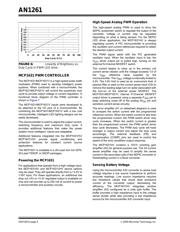herunterladen

© 2009 Microchip Technology Inc. DS01261A-page 1
AN1261
INTRODUCTION
This application note covers the general concept,
design and some source code modifications for using
the MCP1631HV Digitally Controlled Programmable
Current Source Reference Design for an LED lighting
application. The document offers additional insight into
the MCP1631HV Digitally Controlled Programmable
Current Source Reference Design. A Microchip
MCP1631 PWM controller and a low-cost PIC16F616
microcontroller are used to manage a SEPIC (Single
Ended Primary Inductive Converter) powertrain. The
SEPIC topology is then used to drive and dim Light
Emitting Diodes (LEDs).
The LED technology continues to change and evolve.
The energy efficiency (lumens/watt) of today’s LEDs
allows them to replace the classical tungsten filament
and gas vapor lighting systems with solid-state
technology. The most efficient LEDs are able to
perform as well as Compact Fluorescent Lamps (CFL).
The most important advantage of LEDs over tungsten
and gas vapor bulbs is the cycle life. LED lifetimes
currently show a 30% improvement over their
counterparts. LEDs are being used in the automotive
and commercial lighting industries with good results.
LEDs must be carefully integrated into lighting systems
because of their sensitivity to thermal and electrical
stress. The LED current must be optimized for both
thermal and electrical characteristics. Excessive
driving current will deteriorate LED performance,
shorten the lifetime, and cause permanent reduction in
the luminous intensity.
LEDs may be driven using constant current sources in
order to maintain a consistent color output. One low
cost but inefficient solution for driving LEDs is using
series resistors. The series resistor method is very
sensitive to power supply variation. Constant LED
current depends on a constant supply voltage. Any
variation of the voltage supplying the resistor and LED
combination will result in a change in current and thus
a change in output color. There are more efficient
solutions for driving LEDs that save energy and provide
good current control. Two methods of driving an LED
are Constant Current and Pulse Width Modulation
(PWM) current control.
The PWM driver is used to dim an LED and is based
upon the persistence of vision of the human eye. The
current does not flow through the LED continuously.
The PWM period is normally in the range of 100 Hz to
250 Hz. Dimming is obtained by changing the PWM
duty cycle. Variations in supply voltage will directly
affect the LED current.
The Constant Current Source driver is used to supply
the LED with a constant current. The constant current
results in a consistent LED color output. A high
frequency PWM signal may be used to control the
current that is flowing through the LED. The PWM
signal is used to set the LED current and thus the LED
intensity.
The Constant Current Source driver is based upon
driving the LED with a constant current source to obtain
the desired brightness and color. The current source is
controlled by a high frequency PWM signal. The PWM
modulated constant current source is set to the desired
LED current. By changing the PWM duty cycle, the
LED current can be adjusted for desired intensity and
to offset aging.
Constant current driving is recommended to eliminate
light flickering and electrical stress due to voltage
fluctuations. An important observation is the LED is not
affected by the variation of input power supply voltage
that can vary as much as +/- 30% of the nominal value.
The design topology used for this application note will
be the Single Ended Primary Inductive Controller or
SEPIC topology. The SEPIC topology allows both buck
and boost operation. This allows for a constant current
drive output with variations in input voltage. The SEPIC
uses a current sense feedback loop for efficient control.
Microchip’s MCP1631HV Digitally Controlled Program-
mable Current Source Reference Design is used for
this application note.
Author: Valentin C. Constantin
Microchip Technology Inc.
Dimming Power LEDs Using a SEPIC Converter and
MCP1631 PIC Attach PWM Controller








